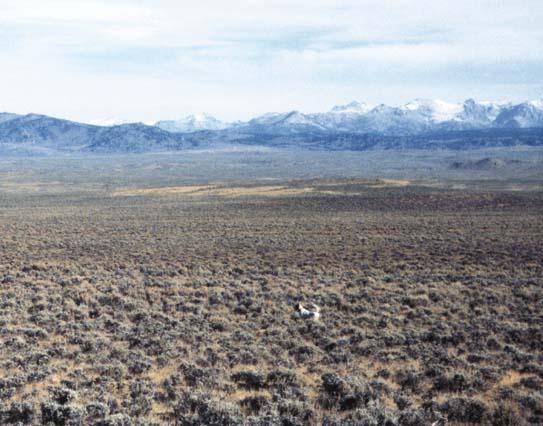
Article and Photography by
David A. Perfetti
Dayton, WY

Benny, finally found him in the middle of nowhere on point.
This year's trip to the sage grouse fields of Wyoming proved to be even more enlightening than in the years past. Many refinements in dog handling, falcon training, and bird hunting found its way into our falconry. This follow-up article will dive into some of the finer points in hunting sage grouse out West. I'll point out some of the more subtle observations, tricks, mistakes, and reasons that make hawking grouse so worthwhile. I'll even find an opportunity to share with you some attitude. I'm gonna tell you how us folk in Wyoming feel. I'm not gonna sugarcoat it, but gonna tell you how it is. I'm gonna rattle on and spark an emotion in your tired blood, so you pansies take heart. The beauty of it is I don't care if you don't like it.
As for grouse hunting, we are all very fortunate this year because the grouse had a great hatch. Sage grouse country in Wyoming is showing signs of a magnificent recovery. This year we have enjoyed numbers of grouse that have not been seen in Wyoming for five years. This also goes for the sharptail and hun populations as well. Lets pray for an easy winter and another good hatch. Next year should be phenomenal and normal numbers of birds will be the result.
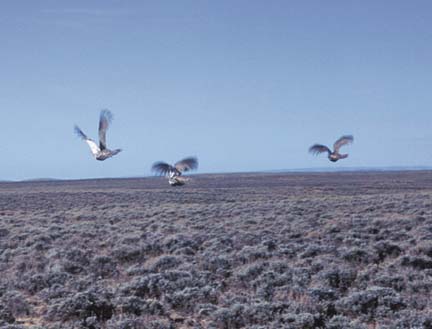
Where's The Grouse?
After a very wet June in Wyoming, the rest of the summer was very dry. Grasshoppers were abundant and young birds had plenty to eat. Berry bushes of all types had a great year, another favorite food of sharptail and huns. The dryness, however, seems to make sage grouse and most other gamebirds congregate at watering holes. In fact, all the sage grouse we found this trip were within 500 yards of water, almost without exception. Water sources ranged from creeks, irrigation ditches, ponds, and even puddles. Speaking of puddles, we observed grouse at dusk moving into shallow water to drink and play. Many young birds in groups would wade into the water and splash around. We also observed grouse mutes, right in the water itself. Other surprising observations besides good numbers and nearness to water was the birds' tendency not to bust. The birds found in remote areas would tolerate dogs, trucks, noise, whistles, yelling, horns, talking and still hold their position. Although this was not the case in areas where gun hunters had easy access. Those birds would bust as soon as detecting our vehicle's presence.
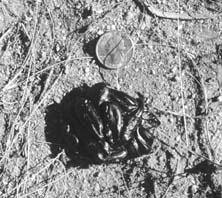
Here is a fresh cecal cast. Note the size, texture, and color (black). These will be scattered throughout an area of normal mutes.
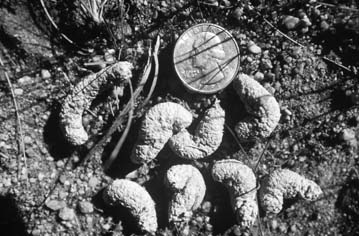
Here are some normal mutes. Note the size, texture, and color (olive green and white). Old mutes are all white.
The grouse we found ranged in group sizes of four to thirty, and there were many singles and doubles. No big honey holes this year of 100 birds. The size of the grouse caught ranged from 30 to 60 ounces (850 to 1701 grams), that's adults, youngsters, male and female. Our 10 day hunt from October 5th to the 15th yielded 17 grouse between three falconers. We probably had 40 quality slips off beautiful points and perfect flushes. We hunted our six dogs and five falcons until the three of us were satisfied. Wyoming regulations limited us to one grouse per day and two in possession per falconer (more on this later). So we ate grouse every night (more on this later also). Steve Jones, Steve Harris DVM, and I, needless to say, had a marvelous trip and 10 days of perfect weather.
Dogs Will Be Dogs
Dogs are a big part of hunting sage grouse. It seems they can never be trained well enough. Age, natural ability, personality, and training all played a part in our dog's performance. Not to mention the dog's physical and mental well-being did also. There were so many grouse this year we had plenty of time and opportunity to observe what each dog did well or not so well. We had six dogs with us, and they all got a chance to find grouse. Two of our dogs were virtually new to sage grouse. They were both prodigies of my setter, Benny. The rest of the dogs had all seen plenty of grouse before. Our dogs consisted of four setters, one English pointer, and one German short hair. The newest grouse performer was Jones' dog, Sedona. Benny's three-year-old daughter has two speeds, fast and fast. She's a big runner, and we found she has two points, one soft and one hard. Her soft point was indicated by a flagging tail (wagging) during which she also constantly looked back to us as to say, "Well I think they're here, but" However, her hard point just the very tip of her tail wiggled really fast and no looking back to us. Now this point always produced a grouse, and we flew them without fear of an unproductive point. When participating in certain activities regularly, you should be paying attention to the subtle details around you. As the years go by, learning should be the result. We figured out these little clues over time because we paid attention to details. We had many grouse to practice on, for this we were fortunate, and we were never hard up for a slip. Even if we busted some birds or didn't get the slip, so what! No use getting excited; we just would go find more.
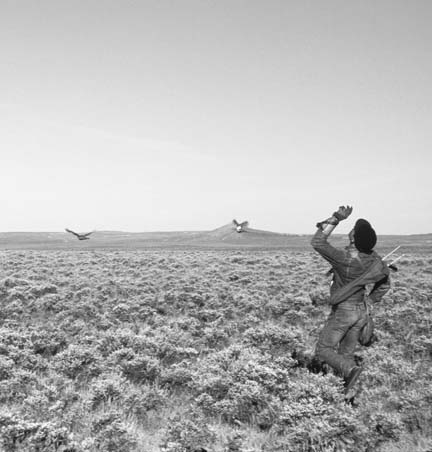
Quite often we experienced joyful neck craning when flying Jones' cast. The flushes were always the highlight of the day.
My dog Benny's other prodigy was his three-year-old son, Barley; even he had his good moments. He's a young male in adolescence, still working out kennel politics and not too serious. Typically male dogs are a little slower to learn, and he's no exception. But, after deciding he too wanted to find a grouse, he showed us a fine point, held for flush, and was quite proud of himself. Here again patience and allowing for opportunity was rewarded by letting a dog have his fun and learn on his own.
The oldest dog, setter Benny, of 10 years developed his own style this year that's been a long time coming and has come to a pinnacle this year. He's always been a big runner with an extremely sensitive nose. He's also a little too independent and took us to our limit this trip. After several days, we figured him out. What at first we interpreted as taking off and hunting on his own, which sometimes he does, needed closer analysis. When we told Benny to find the birds, he got to it. This year quite often he would point his nose into the wind and not stop until he found a grouse. He would sometimes go one or two miles until he locked onto a scent, usually not along the road as planned. In fact, one day he was lost overnight. We thought he was gone forever. He was found the next day 10 miles away after moseying into some fisherman's camp at 2:00 am. An inquiry at the local Forest Service Station revealed his whereabouts. We would, instead of working against him, modify our hunting technique. Find high open ground, tape telemetry on his collar, and let 'em go into the wind. We would watch him with binoculars, track him down with telemetry, find him on point, and fly a grouse. Most of the time it would work, but required some walking. This technique worked well when road hunting, but was not producing any grouse. Morale of the story is if you have a big running dog, don't fool around, wire him up with telemetry or you will lose him in this wide open country.
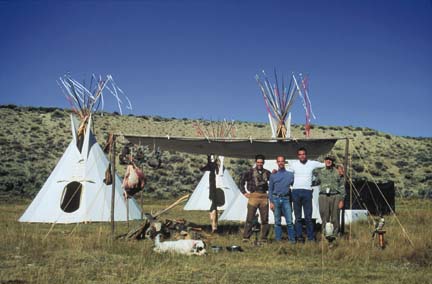
Dave Perfetti, Steve Jones, Steve Harris DVM, Bubba Harris, Benny, and the birds all enjoying the afternoon sun at camp.
The Wind And The Dogs
The wind, or sometimes lack of, would play havoc with our dog's noses. Ben has a technique of pointing a grouse from quite a distance. When on point any change in the wind's direction, he'd have to reposition to regain the scent. Sometimes it took 10 minutes to find his grouse. Luckily my new tiercel hybrid, Bucko, is used to this and follows my dog at pitch until we flush. Some dog's habits can be corrected, but some behavior is best left alone. It's up to us to determine what the dog is doing. There is a fine line between acceptable and unacceptable behavior. Sometimes bad behavior develops from too much freedom. For instance, as of late Ben seems to think with all this freedom he doesn't have to listen either, wrong. Time to rein him in a little.
As far as wind goes, we noticed high winds were the toughest for all the dogs to scent (25 - 30 mph). No wind also was tough; the dogs would be right on top of birds during flushes. But 5 to 10 mph winds were perfect; we got points from as far as 200 yards, and the dogs scented grouse from 1/4 mile away. Note those details, notice what your dog does when they are birdy. One of my setters, Sage, wags his tail furiously when he's on a scent, and he won't point until he's got 'em nailed, tail straight like an arrow. Details, details. If you have enough game, you notice this stuff.

Jones' cast of a female prairie and a tiercel peregrine x gyr hybrid never missed a slip.
The Birds
Oh yeah, this is falconry, but as one can see dogs are an essential ingredient of grouse hawking. It takes years to train a dog and 30 days to train a falcon. Come to grouse camp with your birds ready. Don't put yourself through the frustration of having to train your bird at camp. Know his flying weight before going to camp and keep it there. Have him lure trained and on the wing chasing game before your arrival. If your bird's not ready, he won't be catching any grouse. The grouse are easy to get if your bird's in shape and at proper weight. With most of us having limited time in camp, don't waste it having to train your bird. Do it at home!
One thing to note is after three days in camp, your bird eating sage grouse, and the nights frosty cold, your bird's weight will go down. You have to start feeding more than the usual coturnix quail, almost twice the amount. My bird, Bucko, started lowering his pitch to 300 feet after four days of hunting grouse and lost 1/2 ounce. He ate like a ravenous fool and started not catching grouse. Well dummy, he's weak, feed him more! So with full crops of grouse after flights, his weight went back up to 26 ounces (737 grams), and he started going up to his usual pitch of 800 feet and getting grouse. This leads to more good tips, keep a bird log; note the bird's weight, the temperature at night, and weigh your bird's food. Typically in fall weather, my bird needs 3 ounces (85 grams) of quail to maintain weight. On grouse, he needs 5 or 6 ounces (142 or 170 grams). Document your bird's performance, then you have a record to note trends and its relationship to weight, temperature, wind, and food. Details, details = success. Make adjustments for behavior, both in your dogs and your birds. Just don't be an observer! Don't let emotions come into play; if you don't like something, change something to accommodate it.
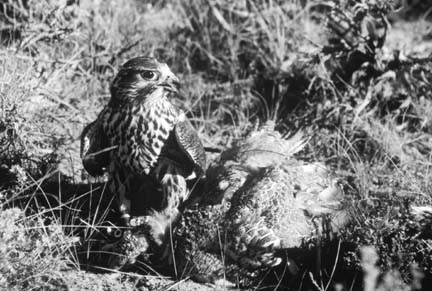
26 ounce gyr hybrid "Bucko" with a 56 ounce sage grouse.
The Right Weight
What's too fat? What's too thin? Well back to the basics of falconry. Proper behavior is measured by performance. Too fat = doesn't come to the lure, flies around with beak open, lands all the time, low pitch. Also you can't feel the keel, about 3/8" of bone felt on the keel of a large falcon is flying weight. As cold weather arrives and training progresses, you can reduce the amount of keel to 1/4" to nothing depending on the individual bird.
Too thin = low pitch, slow weak wing beats, eats like a ravenous fool, too much keel felt (greater than the 3/8" of bone on large falcons), puffed up feathers all the time, eyes closing in the middle of the day, can't fly (now he's getting so low he's gonna die).
When a bird's on weight, he'll pump wings hard up to a pitch of 500 - 1000 feet and fly for 15 to 30 minutes, hang around for a flush, chase game hard, and kill it. He'll also come instantly to the lure from a 1000 foot pitch a mile away. Now you have been paying attention to details. That also brings to mind, don't be pimping your bird on the lure every time he doesn't get anything or you don't produce a flush. After a while, he'll ignore the lure and won't come at all. All you'll see is his vent as he heads over the horizon, flipping you his bird.
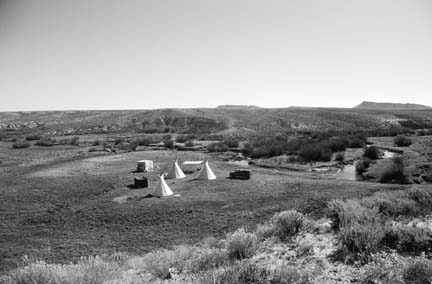
Camp, as viewed from the bluff. Privacy, uninterrupted for 25 miles.
Camp
Camp this year was the way to go! Camping in our grouse hawking area saved us time and money. We saved 100 miles a day of driving by not coming from town to hawk. This also saved three hours of driving time not having to haul the birds and dogs around. Not having a hotel bill was also a pleasure. With the help of Dr. Steve Harris, DVM, we had a deluxe camp complete with solar showers, privy, and a cooking tepee. We probably averaged 50 miles per day driving which included trips to town for ice, food, gas, and other essentials. When out hawking, we would leave camp, find three slips in five miles, and be done by 10:00 am. The hawking was fantastic, the weather was superb, and the company entertaining. We even found time to bag a trophy antelope and weather the birds in the warm sun. The touch of nature during the frosty mornings, the colorful sunrises, and the smell of the high desert overwhelmed our senses. Being surrounded by such a beautiful wilderness, the grouse, the sage, and the antelope made this trip truly a spiritual awakening. We were all inspired into conversations of creation, human nature, politics, and falconry. Hunting this blessed land is truly a privilege that will be remembered.
What Do You Do With A Dead Sage Grouse?
Some people say sage grouse is not edible. To them, I say bullshit. First, let's take proper care of the carcass. Filet the breast meat off the bone as soon as you get back to camp, then wash it. Cut off the wings and legs for hawk food, save the heart and liver and bag it all up. Then properly dispose of the smelly gut pod in a hole you dug into the earth and thank the creator.
Now with these fresh grouse breast filets and hearts, cut them up into thin strips and put them into your favorite marinade. Two average size grouse breasts (four halves) will feed three or four guys.
Recipes
Marinated Grouse Breast Sandwich - 1) Marinate the whole breast halves in a baggie with seasoned salt, olive oil, worschester sauce, and soy sauce. 2) Grill on an oak fire the next day until only medium rare! 3) Serve on your favorite buns with cheese, mayo, lettuce, tomato, and onions.
Mexican Grouse - 1) Cut and marinate chunks overnight like before. 2) Saute the chunks in a pan of olive oil over high heat until rare. 3) Pour in one can of Mexican style stewed tomatoes and simmer for 10 minutes. 4) Serve over rice with grated cheese, onions, and salsa.
Italian Grouse - 1) Cut and marinate chunks overnight. 2) Saute the chunks in olive oil over high heat until rare. 3) Pour in your favorite pasta sauce. 4) Serve over "al dente" linguine with Parmesan cheese on top.
The key to cooking grouse is to cut out all the connective tissue and tendons, and do not overcook it! If it was a steak, you'd call it medium rare - pink in the middle. Enjoy your grouse.
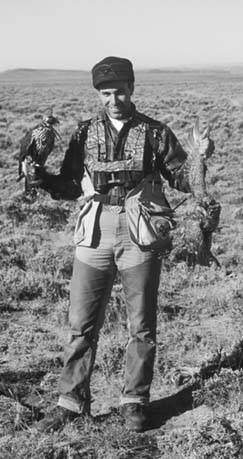
What can I say?
Attitude
Now the fun part, what you've been waiting for. Some attitude. So here it is. In Wyoming, we have a one grouse per day, per falconer limit. That's one grouse per day, not two, not three but one. So if you come to Wyoming with three big tough falcons to fly, after your first grouse of the day, you're done! It's suggested you then go look for a duck or fly the lure. If you don't and you hawk grouse, you're a "poacher." Here in Wyoming, we don't like poachers, so turn your outfit or horse around and head on out. We don't care who you are or who you think you areout. Take heed, same goes for fishing. If you see a sign that says "3 Trout Limit," it means three, not ten, not twenty, not four, but three. The Wyoming Game & Fish set up road blocks all over our remote areas to get you poachers. Game & Fish have a motto here, it goes like this "We are not here to educate, we are here to violate." So don't take more than the limit. That's the way it is. See ya!
P.S. Here are some bonus phone numbers for ordering BLM maps.
$4.00 each by credit card.